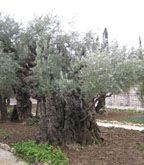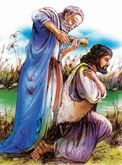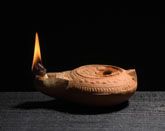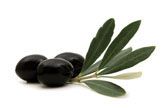×


We have detected your country as:
Please click here to go to the USA website or select another country from the dropdown list.
by: Rev. Cheryl L. Hauer, International Development Director
When God had something to communicate to His people Israel, He often went to great lengths to make sure that He was being heard and understood. From the flash of lightning and crash of thunder to the mighty roaring of the wind to the whisper of the still small voice, He used whatever was necessary to get His points across. In His Word, He uses vivid images to help us truly understand, at a practical level, the instructions and concepts He is attempting to impart.
These word pictures are invaluable for the true student of the Bible, but unfortunately, they are often misunderstood or even completely overlooked. Many of them come from the flora and fauna of ancient Israel, and each one has been handpicked by the Lord for its unique characteristics and its ability to communicate a specific concept. If a word picture is to accomplish its purpose, however, we have to make certain that we understand it in its proper historical and cultural context.

God repeatedly chose the flora of the ancient Middle East to help tell His story. The Bible is rife with images of plants that are strong and bearing fruit, or wilted and dying for lack of water or a good root system. His love for His people is often expressed through analogies of flocks feeding in lush green pastures, His blessings in terms of plentiful fruit and grains, and His protection likened to the sturdy cedars of Lebanon.
There are over 100 species of plants discussed in the Scriptures, and among them—probably the most beloved, sacred, and widely recognized—is the olive tree. Appearing initially in Genesis 8:11 as the first plant to put forth leaves after the great flood, it is mentioned over 30 times throughout the Bible. It is perhaps the most widely used plant illustration in both the Old and New Testaments and is the most commonly used plant to represent Israel herself in the biblical narrative.

Very old olive trees in the Garden of Gethsemane
The logical question would be, why? Why did the Lord repeatedly use this tree, its fruit and its oil as object lessons for His people? It is a beautiful tree that grew abundantly in ancient Israel and continues to be seen on hillsides throughout the Land to this day. When describing the great beauty of Israel when favored by the Lord, the prophet Hosea likens that beauty to the olive tree (14:6).
But the olive tree has characteristics other than physical beauty that make it an apt illustration for His chosen nation. Although it only reaches a height of 5 meters (16 feet) or so, it is remarkably hearty. It is grown throughout the world in both hemispheres from semi-tropical to arid and to the cooler regions of the north, from South Africa to Russia. It is an evergreen, which means it does not lose its leaves during the year but maintains its beautiful gray-green foliage from January to December. Although it can take a number of years for a new tree to bear fruit, once it begins, it is ever-bearing. And it is virtually indestructible.
The tree is well known for its enormously spreading root system, extending many meters around the tree in order to absorb sufficient moisture in the dry conditions in which it normally grows. And only the smallest segment of that root system is required to send forth new shoots, so olive trees are known to survive the best efforts of those who would try to get rid of them. Chopping, uprooting, even burning seldom have their desired effect, and the tree is so tenacious that its shoots grow up through the rockiest of soil. Finally, an olive tree can live to be thousands of years old, with only two other species of trees living longer.
The olive fruit itself provided rich and poor alike with many of the necessities of life in ancient Israel. Oil for cooking, lighting, cosmetics and medicine came from the olive, while the fruit pickled in brine was an important food throughout the year. Its hard, marbled timber was used for special furniture, paneling, and statues. Its oil anointed prophets and kings, and according to Deuteronomy 7:13, it was one of the three essential products of the Land of Promise.

In Deuteronomy 6:11, the Lord promises the Israelites that when they entered the Promised Land, they would receive the benefits of many things for which they did not labor, including vineyards and olive trees. Deuteronomy 8:8 refers to the Promised Land as “a land of olive oil and honey.” Obviously, olive cultivation had already been well established by the Canaanites at the time of the Exodus, and the ongoing production of olive oil as well as the use of the tree and its fruit would be of critical economic importance to the nation of Israel.
During the construction of the Temple, King Solomon sent King Hiram of Tyre over 400,000 liters of olive oil, a huge gift indicating the scale of production in Israel at the time. Some scholars believe this much oil would have required an annual output from over 200,000 trees, requiring an orchard of nearly 5,000 acres (2023 hectares)! We know that olive oil was the only food exported during the Second Temple Period as well. But it was also important on the domestic front. Olive oil was an essential part of every man’s diet, and it is mentioned literally dozens of times in Scripture in partnership with wine and grain as a staple food.

fotomedia/iStockphoto.com
But it wasn’t just for eating. One of the most common finds in archaeological digs throughout Israel is the oil lamp. Some are small open bowls, while others are more stylized with a special spout for a wick. But either way, they relied on olive oil as fuel, and every home in Israel depended on them for light. Outside, the streets were lit with torches that were made with rags soaked in olive oil.
In other words, olive trees were well-known and critically important to each of God’s chosen people in ancient Israel. When He spoke to them using analogies of the olive tree, they knew immediately what He meant. When He illustrated to them that the nation of Israel would be strong and hearty; that His covenant relationship with them would be the root system that would nurture them and cause them to grow wherever they were planted; that regardless of the enemies that came against them, the nation would be virtually indestructible; that they would bear fruit and would fulfill God’s mandate to be a light to the nations, that they would outlive their enemies…the olive tree was their living example.

The first time we encounter God making covenant is in Genesis 9 where he makes a covenant of promise that He will never again destroy the earth by flood. He uses the Hebrew word olam to describe it, a word that simply means everlasting: This covenant would have no end. In Genesis 15, God enters into a covenant relationship with His friend Abraham, and when he elaborates on the covenant in Genesis 17, He uses that same word. Over 20 times in the book of Genesis alone, He reiterates the terms of that covenant, making it clear that it is not only everlasting, but it is also unconditional. His message to Abraham and his offspring is clear: I am giving you this land as an everlasting possession, and I will be your God and you will be My people.
It is unfortunate that many people today don’t understand the meaning of covenant. As I travel around the world on behalf of Bridges for Peace, I often ask Christians a simple question: What is a covenant? The most common answer I receive is a “promise.” A good answer, but not complete. If God is serious about His covenant being everlasting, He must mean something more than a promise. Promises are very easy to break, and even a cursory glance at our own lives or at history gives ample proof that promises are rarely everlasting.
The second most common answer I receive is “treaty.” Again, the answer is incomplete and for the same reason. The history of mankind is littered with broken treaties. Certainly, God means something more than this. The third answer I commonly hear is “contract.” Here we are dealing with the legal aspect of covenant, but this answer is again only partially correct. A contract can be made between strangers and is most often constrained by time parameters. A contract is actually by nature self-limiting. It will either be fulfilled or it will be broken, but in either case, it will eventually become null and void. I believe the correct answer is “relationship.” When God speaks of covenant with His people, He speaks of a coming together in unity and oneness, a union that is not to be separated.

Imageman/Shutterstock.com

Jiri Hera/Shutterstock.com
The story is told of a preacher who wanted to illustrate the true idea of covenant to his congregation. He stood before them one Sunday morning holding two small boxes in his hands. He took the first box and shook it toward the people. It was filled with loose powder and everyone in the first two rows received a dusting with a fine layer of powder. “That,” he said, “is a contract.” But the second box was filled with pressed powder, and no matter how hard he shook it toward the congregation, not one grain of powder was dislodged. “That, my friends,” he said, “is covenant. So tightly pressed together, inextricably linked, so that no matter how hard you are shaken, that link cannot be broken.”
“I will be your God,” He told Abraham, and I give this land to you and your descendants after you as an everlasting possession” (Gen. 17:8). It was a covenant of love, an everlasting relationship. And it was unconditional. Genesis 15 relates a common practice in the ancient Middle East called “cutting a covenant.” Both parties entering into a covenant were required to pass between the rows of sacrificed animals. But God deliberately put Abraham to sleep and passed between the animals alone. What a profound statement this must have made to Abraham! It was clear that God was taking responsibility for the fulfillment of the covenant.

And from that time on, His reputation has been on the line. Would He…could He keep His promise linking Abraham’s descendants to the Land of Israel? In Ezekiel 36, God says that every moment that the Jewish people remained outside that Land, His name was being disgraced, not because of their behavior but because His covenant was not being fulfilled. He promises to bring them back home for His own namesake (v. 22). Today, we see that promise being fulfilled as the Jewish people return to the Land from the four corners of the earth.
Those covenant promises are the soil in which the olive tree of Israel would grow and become strong. God’s covenant relationship with His people would insure that regardless of their dispersion, they would remain the apple of His eye and His treasured possession. He would love them, it says in Jeremiah 31, with an everlasting love. His olive tree would flourish again; it was indeed indestructible.

Petar Ivanov Ishmiriev/Shutterstock.com
According to the dictionary, grafting is a method of plant propagation widely used in agriculture and horticulture where the tissues of one plant are encouraged to fuse with those of another. The practice is thousands of years old. It was a process commonly used by farmers in the ancient Middle East to strengthen their crops and improve their yield, and it is mentioned in Scripture several times.
In its simplest form, a cutting from a plant that contains genes that are to be replicated (the scion) is placed in an opening on the host tree (stock). The raw tissues from both the scion and the stock must come into contact with one another and stay in contact for the graft to be successful. Both must be kept alive and healthy during the process until the two have completely fused. A vascular connection takes place so that sap can freely flow. However, often the structural tissue of wood does not fuse, and the physical point of the graft remains weak. The graft area must be wrapped and protected, sometimes for the entire lifespan of the tree, to keep the new branch from being broken off.
Most often, a scion that is a superior fruit producer is grafted to a stock with a strong root. This usually results in a sturdy plant with prolific fruit. Sometimes, however, a plant with weak roots or with a root system that is tolerant of disease or conditions unfit for the plant itself will be grafted to a similar stock that has a strong, healthy root system. In the case of the ancient Israelite farmer, his olive grove would be strengthened as he grafted scions from his cultivated trees to wild stocks. The scions were superior producers while the wild stocks had sufficiently healthy root systems.
Grafting had many benefits. Not only did it produce plants that were often sturdier and hardier but dramatically increased fruit production. One additional advantage was called precocity. This is the ability to induce fruitfulness without the need for completing what is known as the juvenile phase. Juvenility is the natural state through which a seedling plant must pass before it can become productive. In most fruit trees, juvenility may last between five and nine years, but in some tropical fruit and some species of olive trees, juvenility may last up to 15 years. Grafting of mature scions onto stocks can result in fruit bearing in as little as two years. This could be a tremendous boon for the ancient farmer whose livelihood depended on his olive production.
For Christians, Romans 9–11 are some of the most important chapters in all of Scripture. Here, the Apostle Paul clearly lays out God’s scenario regarding the relationship between Israel and the Church. Here it is made clear that God’s covenant with Israel is indeed an everlasting covenant. Romans 9 tells us that the adoption as sons of God, the covenants, the law, the service of God, and His promises all continue to belong to the Jewish people. Paul gives sound responses to those who would say that God is through with the Jewish people: “I say then, has God cast away His people? Certainly not!…” (Rom. 11:1). “I say then, have they stumbled that they should fall? Certainly not!…” (v. 11).
Romans 11:29 tells us that the gifts and callings of God are irrevocable. By His very nature, He is a God of faithfulness and constancy. His word is altogether trustworthy, and when He says He has entered into an everlasting covenant with the people He has chosen, He means exactly that.
It is in these New Testament chapters that God again uses the olive tree as a word picture to help us understand what Paul calls the “mystery” of this relationship. Romans 11:17 is a great example: “And if some of the branches were broken off, and you, being a wild olive tree, were grafted in among them; and with them became a partaker of the root and fatness of the olive tree…” This is actually one of the most profound verses in all of Scripture, as the Lord, through the apostle Paul, uses this vivid agricultural imagery as a word picture for us. And the message for us today is astounding.

Andrjuss/Shutterstock.com
First of all, Paul tells us that we as Christians are the wild olives, bearing little fruit of any importance with a root system that is weak or tolerant of disease. Contrary to all that we have learned about grafting, Paul says the scion is to come from the wild tree and be grafted into the domestic tree rather than the other way around. He tells us that some, not all, of the natural branches have been removed to make a place for the scions from the wild tree. We are to be grafted in among them, not replacing them on the tree, not overtaking the tree and forcing the rest of the branches out, but partaking of the sap together.
That means that raw tissue must come together and stay together for the graft to be successful. We are living in a day of restoration and relationship-building between Christians and Jews, and we must be willing for that raw tissue to be exposed. We must look honestly at our history with the Jewish people and be willing to own it. We must be willing to be open, transparent, and honest in our relationship-building, and we must make sure that those relationships are marked by sincerity and respect. We must be willing to see ourselves as the Jewish people see us after nearly 2,000 years of Christian anti-Semitism.
Remember, both the scion and the stock must remain alive and healthy during the grafting process. For nearly 2,000 years, the Church ignored that admonition and attempted to promote its own life at the expense of the Jewish people. Today, we must make it our objective to support the Jewish people, bringing life and encouragement wherever possible.
As the relationship between Christians and Jews strengthens and the graft begins to take, we are seeing an exchange of ideas, an openness of communication, a flowing of the sap. Christians are learning about their history and connecting to their ancient heritage; Jews are discovering that many Christians are, in fact, their friends and not the enemy that has marked Christianity in the past. We are learning together about the things we share in common.
But we must remember that the graft needs to be protected. Structurally, it remains very fragile, and we must work to be prayerful and sensitive, remembering Paul’s admonition that the grafted branches can indeed be broken off if we should fall again into arrogance, boasting against the natural branches. “You will say then, ‘Branches were broken off that I might be grafted in.’ Well said…Do not be haughty, but fear. For if God did not spare the natural branches, He may not spare you either” (Rom. 11:19–21). We are to fear what might happen if we forget that it is the root that supports us (v. 18). The word for “fear” is phobeo, and it means alarm, anxiety, panic that causes you to run away. In other words, this is very serious business.

arka38/Shutterstock.com
Romans 11:33 proclaims, “Oh the depth of the riches both of the wisdom and knowledge of God! How unsearchable are His judgments and His ways past finding out! For who has known the mind of the Lord?…” How can we begin to understand the goodness of the Lord who grafted us, wild olives that we are, into His olive tree which is Israel, allowing us to become partakers of the root and fatness of that tree? How can we comprehend His kindness that made a way for us as Gentiles to come alongside His people and become a part of what He was already doing? How can we grasp the goodness of a God that desires nothing more than to have mercy on us all? And what can we possibly say in response but thank you.
Photo Credit: Photo by Eddelene Marais
Packer, J. I.; Merrill C. Tenney, and William White Jr. Illustrated Encyclopedia of Bible Facts. Nashville, TN: Thomas Nelson Publishers, 1995.
Telushkin, Rabbi Joseph. Jewish Literacy. New York: William Morrow and Co, Inc, 1991.
North Carolina Cooperative Extension Service. “Grafting”. North Carolina State University. http://www.ces.ncsu.edu/depts/hort/hil/grafting.html
Wikipedia. “Grafting.” http://en.wikipedia.org/wiki/Grafting
All logos and trademarks in this site are property of their respective owner. All other materials are property of Bridges for Peace. Copyright © 2025.
Website Site Design by J-Town Internet Services Ltd. - Based in Jerusalem and Serving the World.